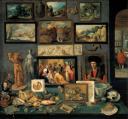Think of all the work you do while you’re a student at Macaulay. Assignments for classes, projects, a thesis, essays, photography, videos, musical performances, websites, blogs, wikis, mathematical formulae, scientific research or experiments, short stories, poetry…even more. Then think beyond that. Think of the other kinds of work you also do, that might be less formal, or less “official.” Conversations with friends, interesting websites that have influenced your thinking and learning, books you’ve read on your own, places you’ve visited, souvenirs, emails…and even more than that, too.
 All of these are “artifacts” of your thinking, your learning, your self while you’re a Macaulay Honors College student. If you could put it all together, in a cabinet, or a room (or a huge building!), you would have a cabinet of curiosities (a wunderkammer). It could be the museum of you–and you could invite people in to take a look. You could decide which rooms in your museum would be good for showing to which audience, depending on what you wanted them to know about you. You could keep some rooms private, only for you, and you could have other rooms that you showed only to special people.
All of these are “artifacts” of your thinking, your learning, your self while you’re a Macaulay Honors College student. If you could put it all together, in a cabinet, or a room (or a huge building!), you would have a cabinet of curiosities (a wunderkammer). It could be the museum of you–and you could invite people in to take a look. You could decide which rooms in your museum would be good for showing to which audience, depending on what you wanted them to know about you. You could keep some rooms private, only for you, and you could have other rooms that you showed only to special people.
Even better, you could spend some time by yourself or with a few friends or colleagues, walking through the rooms, looking over all your artifacts, and thinking about what they mean to you, what they show about you. And as time goes by you might have different thoughts about each artifact, because when you learn more, you see things in a different way. And when you show your artifacts to friends and colleagues, they might be able to point out things that you missed yourself–things you didn’t know you were learning. Then when you show the rooms in your museum to other people, you could tell them some of what you thought–you could guide them through your museum, explaining why you chose to include the artifacts, describing how you got them, and how they relate to other objects. You might even want to move things around, or make new rooms, or make a new map that shows how different rooms or shelves relate to each other.
And in a way, that’s what an eportfolio is. It’s a digital representation of your cabinet of curiosities, your wunderkammer, your museum of you. You get to build it, put your artifacts into it, design it, redesign it, think about, show it to other people, get their comments, and tell them what you think.
Your eportfolio continues to change and grow–and you continue to look back on it. But first you have to start building it!

